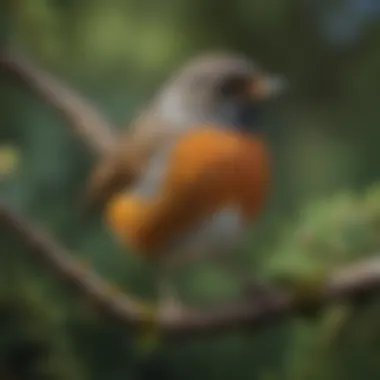Understanding the Robin Bird Call: Characteristics and Significance


Intro
The robin bird call is a subject that intertwines the intricate details of avian communication with broader ecological implications. Understanding this call requires a close examination of its characteristics and the significance it holds in the lives of these birds, and, by extension, the ecosystems they inhabit. As environmental changes continue to threaten many species, a focus on the robin's vocalizations also sheds light on conservation challenges. This article aims to provide a comprehensive examination, offering insights for both enthusiasts and professionals in the field of ornithology and conservation.
Characteristics of the Robin Bird Call
The robin is well-known for its melodious and varied calls. These calls serve multiple purposes, including mate attraction, territory assertion, and communications regarding danger. The most recognized sound is the 'cheer-up, cheerily' song during the mating season. This song can be heard at dawn and dusk, marking territorial boundaries and signaling reproductive readiness. In addition to the song, robins produce various calls, including alarm calls, which are sharper and short. These calls can change in intensity, often reflecting the urgency of a situation.
Significance of the Robin Bird Call
The robin's call plays a crucial role in their social structure. The calls foster relationships and ensure the survival of the species. The vocalizations also indicate seasonal changes, as robins adjust their call patterns based on mating behaviors and environmental factors. These timing shifts reflect the health of their environment, serving as an indicator of habitat conditions. In a conservation context, monitoring these calls can provide valuable data about changing ecosystems. Assessing the clarity and frequency of robin calls can indicate population health and biodiversity levels in varied landscapes.
Seasonal Variations in Robin Calls
Robins transition through different calling patterns with the seasons. During spring, the reproductive calls become more pronounced, attracting potential mates. Summer sees a mix of song and calling to communicate with fledglings. As autumn arrives, the calling lessens, with a focus on gathering for migration if necessary. The winter months signal a quieter period; however, winter calls can still be indicative of regional changes in their behavior and habitat suitability.
Habitat Loss and Its Impact on Robin Populations
The ongoing loss of habitat poses a serious threat to robin populations. Urbanization, deforestation, and agriculture encroach on their natural environments. This loss disrupts their nesting and feeding habits, leading to decreased survival rates. In some regions, these pressures have significantly impacted not just the robins, but entire ecosystems. Consequently, advocating for conservation strategies becomes vital in preserving this species.
Conservation Strategies for Robins
Several strategies aim to mitigate the impacts of habitat loss.
- Restoration of Native Vegetation: Planting native trees and shrubs can enhance nesting sites and food availability for robins.
- Creating Wildlife Corridors: Establishing clear pathways through urban areas helps facilitate migration and genetic diversity.
- Public Awareness Programs: Educational initiatives can engage community members in conservation efforts.
"Protecting the robin is not just about saving one species; it's a commitment to the health of the entire ecosystem."
By employing these strategies effectively, conservationists can protect robin birds and promote resilience in their populations. As they adapt to changing environments, it is important to continue studying their calls—this knowledge directly supports broader ecological health and facilitates successful conservation efforts.
Preface to the Robin Bird Call
The robin, recognized for its distinctive bright orange breast, has a complex vocal repertoire that serves various essential functions within its ecology. Understanding the robin bird call is not solely about identifying the sound itself, but delves into its underlying significance to the species and broader avian communication.
Defining the Robin Bird Call
The robin's call typically features a series of melodious phrases. Often described as cheerful or melodic, its calls can include a range of distinct sounds that convey different messages. These calls serve multiple purposes such as signaling territoriality, attracting mates, and communicating with their young. The unique tonal qualities of the robin's song can easily distinguish it from other birds in the environment.
Notably, adult robins will use early morning and late evening calls to establish territory and reinforce their presence in the area. This is essential for maintaining their breeding grounds and warding off intruders.
Importance of Bird Calls in Avian Life
Bird calls play a critical role in avian life by facilitating communication among species. Calls are used for various purposes, including:
- Mating: Helps in attracting potential mates during breeding season.
- Territoriality: Establishes dominance and deters competing species from encroaching on established habitats.
- Coordination: Assists in coordinating group activities, especially during foraging or migration.
- Alarm: Warns other birds of predators, ensuring the safety of the flock.
By analyzing the robin's call, ornithologists gain insights into not only the robin’s behavior but also the health of the ecosystems they inhabit. Understanding these calls can be vital for conservation efforts, as changes in vocalizations may indicate stress due to environmental pressures.
"Bird calls are a window into the world of avian interaction, revealing much about their social structure and ecological health."
The robin bird call is a crucial element in understanding both individual and collective behaviors in birds. This section sets the stage for analyzing the characteristics, significance, and conservation needs relating to these calls, highlighting the robin's integral role in the avian community.
Characteristics of the Robin Call


The call of the robin is a defining feature of this species, serving multiple functions in its daily life. Understanding the characteristics of the robin call is essential for appreciating how these birds interact with their environment. The robin's call provides critical information to both the birds themselves and those studying them. Characteristics such as physical attributes, variability in patterns, and pitch play a pivotal role in their communication.
Physical Attributes of the Call
The robin's call consists of a series of melodious phrases that can be distinctively recognized. Each call has a series of notes that may range from soft and subdued to bright and clear. The common American robin's call is often described as a cheerful "cheer-up, cheerily, cheer-up" sound. This unique composition allows the robin to convey different messages depending on their situation.
The physical sound waves produced by a robin can be analyzed in terms of frequency, amplitude, and duration. Typically, these calls have a fundamental frequency between 1 kHz and 3 kHz. The frequency of the sound is crucial as it impacts how well the call travels through various environments, like woodlands or urban areas. Therefore, knowing these attributes aids researchers in understanding a robin’s habitat preferences.
Variability in Call Patterns
Robins exhibit a fascinating range of call patterns based on situational context. There are calls for mating, alarming others in response to predators, and distinctive territorial calls. Each of these categories serves a specific function in their social structure.
"Birds use calls not just for mating, but for establishing territory and signaling alarm."
The variability can be extensive. For instance, a male robin competes with others nearby, producing loud and assertive calls to establish his territory. In contrast, a softer and more melodic call can indicate a presence of potential mates. Observational studies suggest that call frequency can change throughout the day or in response to weather conditions, providing further depth to their communication style.
Pitch and Tone Analysis
Understanding the pitch and tone of the robin's call can reveal much about its emotional state and environmental context. When robins are feeling threatened, their calls may become sharper and more urgent. This high-pitched tone tends to alert other robins to potential dangers.
Conversely, during courtship or relaxed settings, the pitch may lower, exhibiting softer tones that are more melodious. Research indicates that variations in pitch also correlate with geographical regions, which could influence local robin populations. In this sense, pitch analysis is vital for studying how these birds adapt to different environments.
In summary, the characteristics of the robin call are multi-dimensional, consisting of physical attributes, variability in patterns, and pitch nuances, all informing their communication strategies and social behaviors.
Contextual Significance of the Robin Call
The contextual significance of the robin call extends beyond mere sound. It plays a critical role in the life and survival of the species. Understanding this importance can offer insights into habitat dynamics and ecological health. Bird calls, including that of the robin, facilitate communication among individuals and across species. They are crucial for mating, establishing territories, and conveying warnings.
Territorial Claims and Mating Calls
The robin’s call serves primarily as a means of territorial defense. Males use their distinctive song to assert dominance over their territory. This territorial declaration is vital during the breeding season, as it not only deters potential intruders but also attracts females. A strong, resonant call can signal a healthy and fit male, potentially leading to successful mating. Researchers have found a correlation between the quality of a male's call and its breeding success.
Beyond establishing territory, these calls are also integral in the courtship process. Males often sing to impress females, demonstrating their vitality and fitness. This behavior is observed not only in robins but in many avian species.
Communication with Other Species
Robins also use their calls for interspecies communication. The various sounds they produce can alert other birds to threats, like predators. This social communication extends to diverse species within their habitat, contributing to an intertwined ecological web.
Effective communication among species can promote mutual survival, which reveals the broader implications of avian vocalization.
The robin's call, distinctively melodious, can even influence the behavior of other wildlife. For example, its presence might attract other songbirds into an area, creating a richer soundscape and encouraging greater biodiversity.
Seasonal Variations in Robin Calls
The study of seasonal variations in robin calls is essential for understanding the behavioral ecology of this species. The robin's vocalizations change not only with the time of year but also in response to environmental cues. These variations can provide insights into the robin's life cycle, mating behavior, and social interactions. Understanding these calls during different seasons helps in recognizing the adaptive strategies that robins employ as they navigate their habitats.
Spring and Summer Calls
During spring and summer, the robin's calls become lively and frequent. This period is crucial for mating, and the vocalizations serve as important signals. The male robins establish territories by singing loudly, often at dawn. This behavior is not merely for attracting mates, but also for warning other males to keep their distance. Their calls are characterized by a clear, melodious quality that signifies a sense of urgency and claim over a specific area.
In addition to territorial calls, robins also utilize softer, more intricate songs during courtship. Males perform these songs to woo females, often exhibiting variations to increase their appeal. It is noted that the complexity of the male's song can be an indicator of his fitness. Research shows that females tend to prefer males with more elaborate song patterns, associating them with better genes and territory quality.
Fall and Winter Adaptations


As fall approaches, the robin's calls undergo notable changes. The vocalizations become less frequent and often less complex. During this time, robins often gather in larger flocks, and their communication shifts from territorial claims to social calls within the group. The calls heard during fall are more subdued, focusing on maintaining group cohesion and facilitating foraging activities.
In winter, robins tend to modify their calls further. They rely on a range of soft whistles and mellow chirps. These sounds are essential for maintaining communication within flocks while avoiding drawing attention from predators. The simplicity and frequency of calls in winter reflect the robins' need to adapt to harsher conditions.
Human Impact on Robin Call Patterns
Human activities have a significant influence on the call patterns of the American robin. As key elements in their communication system, these calls are essential for mating, territory establishment, and social interactions. Understanding how human factors disrupt these natural call patterns is crucial for both conservation efforts and the overall health of the robin populations.
Effects of Urbanization
Urbanization presents numerous challenges to the nesting and foraging habitats of robins. The expansion of cities leads to habitat fragmentation, which directly limits robin populations' access to resources. Consequently, robins may alter their calls. For instance, they often increase their vocal volume to compete with urban noise from traffic, construction, and human activities. This change not only affects their ability to communicate effectively but may also impact breeding success.
- Increased Noise: The constant din alters how and when robins call, potentially leading to misunderstandings among mates.
- Habitat Loss: With fewer natural spaces, robins have less opportunity for natural courtship displays.
- Adaptation to Environment: Robins might adjust their calls, using frequencies that can cut through urban noise, thus changing the characteristics of their calls over generations.
These adaptations highlight a complex interplay between environment and behavior, indicating a need for monitoring urban habitats to understand the long-term implications of urbanization on robin communication.
Climate Change Implications
Climate change is another factor that threatens the integrity of robin calls. As temperature patterns shift and seasons become less predictable, robins may adjust their calling behavior to align with new environmental cues. Some important considerations include:
- Shift in Breeding Timing: Earlier springs may lead to premature calling, which can misalign with mate availability, affecting reproductive success.
- Resource Availability: Changes in insect populations and vegetation cycles, crucial for feeding, may cause robins to adapt their vocalizations to different habitats they utilize in response to warming temperatures.
- Altered Migration Patterns: Variations in migration cues may lead to differences in vocal behavior, impacting how robins signal their presence in breeding territories.
"The study of how climate change influences avian communication offers key insights into the adaptability of species like the robin."
Recognizing these impacts allows for better-informed decisions in habitat management and conservation strategies.
As our understanding of the relationship between human activities and robin call patterns develops, it becomes increasingly important to integrate this knowledge into effective wildlife conservation plans. Safeguarding habitats, reducing urban noise, and monitoring climate effects are necessary steps in protecting the future of this iconic species.
Conservation of the Robin Species
The conservation of the robin species is a critical concern for both ecologists and enthusiasts. Robins play a vital role in their ecosystems. They control insect populations and contribute to seed dispersal. Understanding the challenges they face can lead to effective conservation strategies that protect these birds and the health of their habitats.
Threats Facing Robin Populations
Robins, like many bird species, are vulnerable to various threats in their environments. One of the primary concerns is habitat loss. Urbanization has transformed large areas of land, disrupting the natural habitats robins rely on for nesting and feeding. As forests are cleared for development, robins often lose the tree cover essential for their survival.
In addition to habitat loss, pesticides and other chemicals used in agriculture pose significant risks. These substances reduce the availability of food sources for robins, impacting their nutrition and overall health. Climate change is also a growing concern, affecting migration patterns and seasonal behavior in robins. Studies show that shifting temperatures can lead to mismatches in food availability and breeding times, which could threaten population stability.
Other factors include predation from domestic cats and other wildlife that have become more prevalent in urban settings. The increase in collisions with windows and vehicles further exacerbates the struggles facing robin populations.
Effective Conservation Strategies
Addressing the challenges robins face requires a multifaceted approach. Key strategies include:
- Restoration of Natural Habitats: Efforts must be made to restore and preserve the habitats that robins depend on. This includes creating green spaces in urban areas and protecting existing forests.
- Public Awareness Campaigns: Educating the public about the importance of robins and the threats they face can foster a culture of conservation. Engaging community members in local birdwatching initiatives or citizen science projects can also promote interest and action.
- Legislation and Policy Changes: Stronger environmental regulations targeting pesticide usage and promoting organic farming can contribute to better food availability for robins.
- Monitoring and Research: Continuous monitoring of robin populations can help identify trends and respond promptly to declines. Research into their breeding patterns and habitat preferences can inform effective management strategies.
"Conservation strategies must integrate ecological insights and community engagement to be truly effective."
Through these efforts, it is possible to create a more stable environment for the robin species, ensuring their presence for future generations.
Methodologies for Studying Bird Calls
Studying bird calls, particularly those of the robin, is crucial for various reasons. First, understanding these calls contributes significantly to our knowledge of avian behavior and ecology. Calls are not merely sounds; they serve as vital communication channels among birds. The complexities of these communications can reflect changes in their environments and signal distinct social dynamics. Furthermore, effective methodologies can enable researchers to conduct thorough assessments of avian populations, which is important for their conservation. Selecting appropriate methods ensures that data gathered is precise, reliable, and applicable to ongoing conservation efforts.


Field Recording Techniques
Field recording techniques play a fundamental role in capturing the nuances of robin calls. High-quality audio recordings are essential for studying the frequency, duration, and patterns of these calls. One widely used method involves the use of portable audio recorders, which can be strategically placed in areas where robins are known to frequent.
Commonly utilized equipment includes:
- Directional microphones to focus on specific calls while minimizing background noise.
- Windshields to reduce wind noise in outdoor environments.
- Digital audio recorders with high sampling rates to ensure clear sound quality.
Careful attention must be given to the timing of recordings. Recording during peak activity periods, such as dawn or dusk, may yield richer datasets. Researchers also often employ random sampling to gather a comprehensive range of call types throughout different seasons.
Analysis of Acoustic Data
The analysis of acoustic data provides insights into the vocal behavior of robins and others birds. Once field recordings are collected, various software tools can be used to analyze the data. Analyzing acoustic data involves looking at elements like pitch, rhythm, and pattern recognition. Software like Raven Pro or Audacity can facilitate this process, allowing researchers to visualize sound waves and identify distinct call patterns.
Key considerations in analysis include:
- Spectrographic analysis to see frequency ranges of the calls.
- Temporal structure analysis to understand timing and duration of calls.
- Contextual analysis to correlate calls with specific behaviors or environmental conditions.
By employing these methodologies, researchers can better understand the ecological roles of robin calls in various contexts. This understanding is essential not only for academic inquiry but also for practical conservation strategies aimed at protecting avian life.
The Future of Robin Calls in Changing Ecosystems
The exploration of how robin bird calls will evolve in the wake of dynamic environmental shifts is essential. As ecosystems adapt to numerous stressors, including urbanization and climate change, these alterations directly impact robin populations and their communication methods. The sonic landscape that robins occupy is increasingly becoming fragmented, which can hinder their ability to convey critical messages related to territory, mating, and alarm signaling. The future of their calls may not only reflect their adaptability but also serve as an indicator of overall ecosystem health.
Adaptations to Environmental Changes
Robins are known for their resilience, but environmental changes pose significant challenges. Alterations in habitat can lead to changes in call frequency and pitch. For instance, robins may start to modify their calls to overcome noise pollution generated by cities. This adaptation can be crucial for mating success and territory establishment.
Natural selection may favor individuals who can adjust their calls effectively.
- Increased Frequency of Calls: As urban areas expand, robins need to increase call frequency. This change helps them communicate over the din of traffic and human activity.
- Pitch Adjustments: Robins may alter the pitch of their calls in response to background noise, aiming to ensure the clarity of their messages.
Understanding these adaptations is critical for both conservationists and researchers. It tells us how robins might thrive or struggle in rapidly changing environments.
Role of Citizen Science in Observation
Citizen science emerges as a powerful tool in monitoring the future of robin calls. Engaging the community in observation can yield valuable data. Enthusiasts and amateur birdwatchers are crucial allies in tracking shifts in robin call patterns. Their contributions can help fill gaps in scientific research, particularly over vast areas where resources are limited.
- Data Collection through Apps: With the rise of mobile technology, apps like eBird and Merlin Bird ID enhance the ability to record and analyze robin calls.
- Community Events: Organizing local observation events can raise awareness about robins and their ecological significance, fostering a sense of stewardship among participants.
Engaging the public in scientific inquiry not only enriches data collection but also bolsters community appreciation for avian biodiversity.
In summary, the future of robin calls in changing ecosystems hinges on their adaptive responses to environmental pressures and the active involvement of citizen scientists in monitoring these changes. Together, these elements can shape a more informed approach to conservation efforts, ensuring that robin populations continue to thrive while navigating a complex web of challenges.
End
Understanding the robin bird call encompasses various significant aspects that contribute to the appreciation of avian communication and its role in the ecosystem. This article has highlighted the intricate characteristics of the robin's call, from its physical attributes to its variability and seasonal changes. Such insights are crucial for forestry professionals and academics who seek to deepen their knowledge on bird behavior and conservation.
Summary of Key Insights
The analysis of the robin’s call reveals its multi-faceted nature. Key points include:
- Variability in Call Patterns: The robin's call is not static; it changes based on the season and context, demonstrating adaptability.
- Ecological Significance: These calls play essential roles in communication for territory establishment, mate attraction, and interaction with other species.
- Impact of Human Activity: Urbanization and climate change affect robin populations and their calls, which can lead to shifts in their natural behavior.
By grounding these insights within broader ecological frameworks, we appreciate how robins serve as indicators of environmental health. Robin calls are not just sounds; they are integral to the survival and thriving of the species.
Call to Action for Conservation Efforts
The urgency of conservation efforts cannot be overstated. As articulate messengers of their environments, robins face numerous threats that hinder their populations. Attention needs to be directed towards:
- Habitat Protection: Creating and maintaining safe habitats is crucial for robins and many other species dependent on similar ecosystems.
- Public Awareness: Engaging the public in conservation initiatives can lead to better protection policies and community participation.
- Collaboration with Researchers: Utilizing citizen science can enhance data collection about robin calls and population trends, informing effective strategies.
"The robin is more than just a songbird; it is a barometer of ecological health, compelling us to listen and respond."







